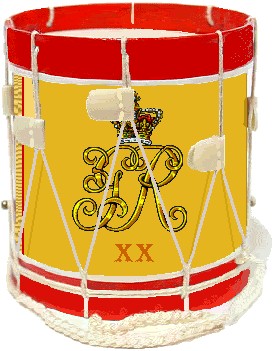XXth Regiment of Foot


In the center of each colour is to be painted, or embroidered, in gold
Roman characters, the number of the rank of the regiment, within the
wreath of roses and thistles on the same stalk. The second Colour to be
the colour of the facing of the regiment, with the Union in the upper
canton; except those regiments which are faced with red, white, or black.
The 20th was first raised in Devonshire, England
in 1688 under Sir Richard Peyton, and was known as
Peyton's Regiment of Foot. Peyton's Regiment served
under King William III during the 'Glorious Revolution'
and saw action at the battle of the Boyne in July of 1690.
During the War of Spanish Succession (1701-1714), the regiment,
while serving with the fleet as marines, took part in the capture of
Spanish galleons at Vigo Bay in 1702. The regiment also saw action
at Guadeloupe in May of 1703 and at La Caya in May of 1709.
During the time of King George’s War, the regiment distinguished itself
at the Battle of Dettingen in June 1743 and Fontenoy in May of 1745.
The Jacobite Rebellion of 1745 brought the regiment to
the Battle of Culloden in April of 1746. The regiment
was designated the 20th Regiment of Foot in 1751.
During the Seven Years War the regiment earned its second
battle honor at the Battle of Minden on August 1, 1759.
The 20th Regiment of Foot arrived in North America, landing in
Quebec in April of 1776. The regiment was among the troops sent
to the relief of Quebec in May 1776, and served under General
John Burgoyne for the remainder of the Canadian Campaign.
The 20th Foot was captured with General Burgoyne at Saratoga
and remained imprisoned until returning to England in 1781.
The 20th Regiment of Foot was granted the county title
of the East Devonshire Regiment in 1782.

The front [of the drums] to be painted with the colour of the facing
of the regiment, with the King's cypher and crown, and the
number of the regiment under it.
if you arrived at this page from a search engine click here to load the menu page



